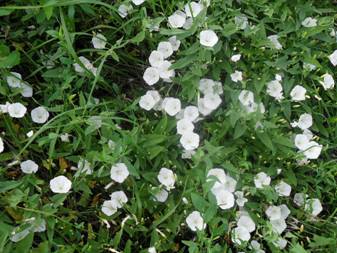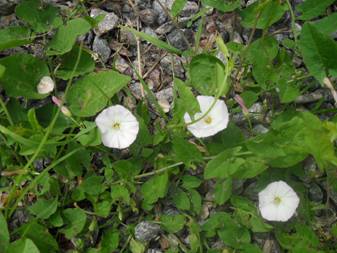

Field Bindweed (Convolvulus arvensis), fam. Convolvulaceae.
A nasty weed. The Mediterranean is considered its motherland, but now its is difficult to state surely, as this plant has occupied most part of the world's land. In Kyiv, it is mostly found in the city, along the roads.
This plant is toxic, though some animals (pigs) can eat it liberally, but others (sheep, horses) can be poisoned if they eat large amounts of bindweed. The herb and roots (more rarely, flowers and seeds) are used in folk medicine as a laxative, diuretic, choleretic and hypotensive, and also against asthma and bronchitis. It is recommended to use fresh, since drying decreases the medicinal value significantly. Overdose causes nausea, vomiting, diarrhea, dehydration, nervous disorders, and it is severely dangerous for pregnant women.
In principle, bindweed is quite ornamental, though inferior to the relative morning glory. However, due to difficult control, its is better not to plant intentionally. One of the means to fight the bindweed is thorough weeding, before the seeds have ripened. The plant can propagate itself only through seeds and rootstocks, so it is important not to leave any root residues in the soil. On the other hand, the cut seedless shoots are harmless, and even may be used as a mulch – they provide benefits by suppressing mold fungi. If the degree of bindweed infestation is high – it is the best to cover the soil with black film long-term, though regular mulching with straw or sawdust, or displacement by other plants (green manure) may also be useful. Chemicals are not very efficient – they only kill the green plants, but several years after that bindweed will recrudesce from the seeds and roots.